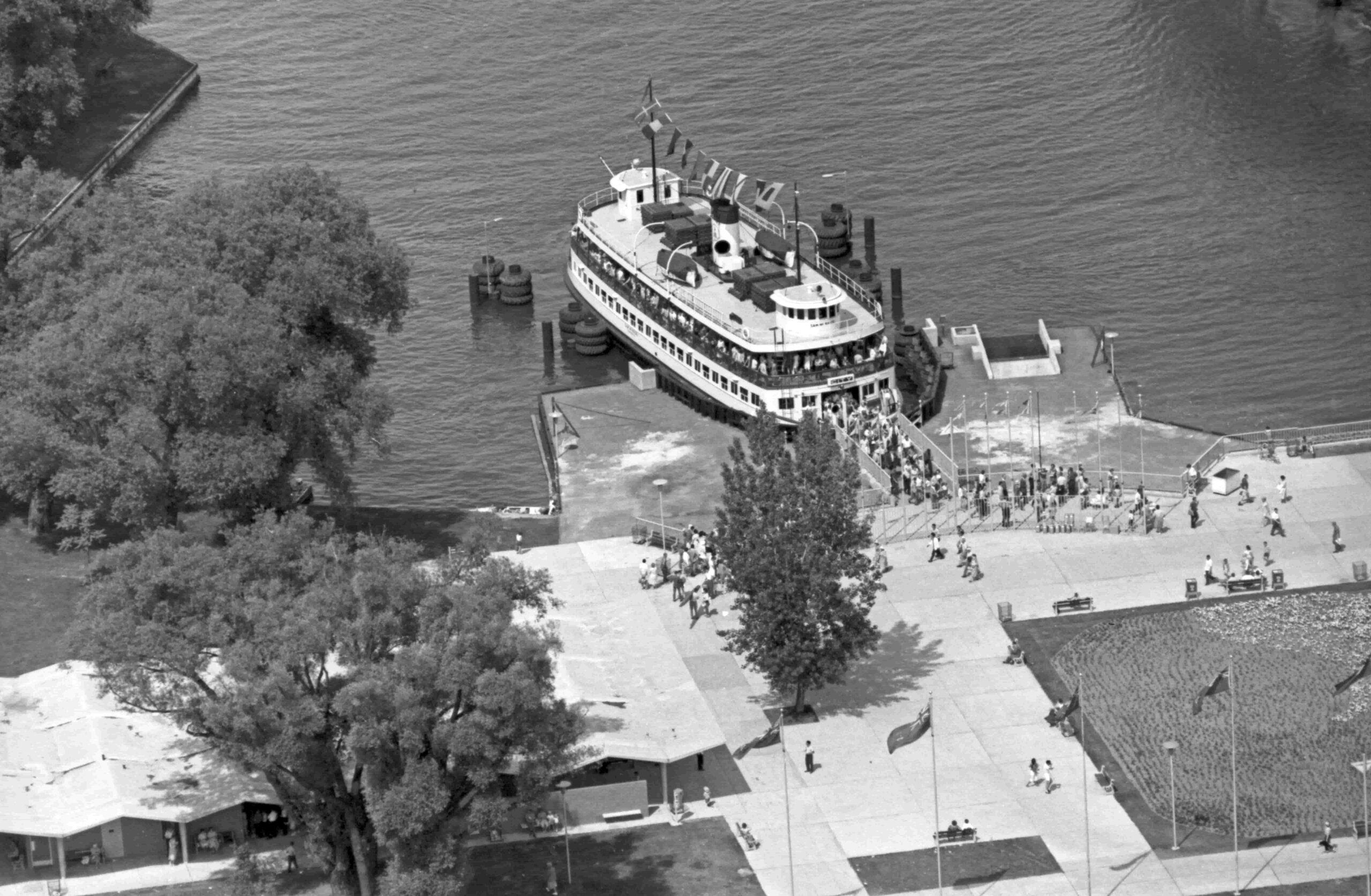It’s been over 20 years since Toronto’s elected leaders officially designated Hanlan’s Point Beach, located on Toronto Island, as clothing-optional. Two decades of relative inattention later, and the City of Toronto has once again set its sights on what’s considered one of Canada’s most important and historied LGBTQ2S+ spaces.
More accessible paths, shuttles from the ferry dock and a permanent Pride flag are all steps the City is imagining for Hanlan’s in a draft strategic master plan aiming to “guide change and investment” on the entire island, portions of which were released in late 2022.
But it’s one proposed change to Hanlan’s that’s drawing alarm and ire from community members who frequent the beach: a recommended permanent “festival space” at Hanlan’s Point, the grassy fields surrounding the beach.
“There is a massive disconnect between what the master plan is proposing and what the people who use this part of the islands want,” says Travis Myers, a member of Hands off Hanlan’s—a group of about a dozen concerned beach-goers who organized in the wake of the City’s November 2022 feedback sessions.
The group’s goals, Myers says, are threefold: the City’s plan should reveal the island’s queer history, respect the unique community who uses the space and rewild the rare ecology at Hanlan’s and elsewhere. He fails to see how a permanent festival space accomplishes any of those goals.
Others agree. In just weeks, Hands off Hanlan’s has gained and galvanized thousands of social media followers—elevating the issue enough that Toronto councillors Ausma Malik (representing the islands) and Chris Moise (representing the city’s LGBTQ2S+ Village) attempted to lower temperatures about what’s happening to Hanlan’s in a joint statement.
Yet the City continues to feel the heat. After an originally scheduled Feb. 27 community consultation about Hanlan’s quickly reached capacity, the City organized an additional virtual forum on Feb. 23 to specifically discuss the proposed festival space, released a public survey about the proposal and promised to organize more virtual forums around Hanlan’s.
What does a “festival space” for Hanlan’s actually mean?
The City hopes this additional forum will dispel a lot of the confusion about what exactly they’re proposing in the draft plan, and how flexible that proposal still is. For instance, Hands off Hanlan’s has referred to the proposed space as a “large-scale concert festival venue” of “200,000 square feet,” but the City says that mischaracterizes their vision.
Daniel Fusca, a manager for public consultation with Toronto’s Parks, Forestry & Recreation department, admits that the term “festival” and accompanying visuals of an existing concert stage in the draft documents lead people to picture something grander than what he and his team intended, which would not include any massive concert structure, but rather more modest installments of power sources and sloping, amphitheatre-style seating.
“The lack of permanent infrastructure like that makes it very expensive to host events on the island, meaning only big things like Electric Island can happen there because they’re the only ones who can afford the high cost of bringing all that equipment over,” says Fusca, referencing a music festival that has been hosted at Hanlan’s Point before.
“If we want to have a wider variety of smaller, more community-focused events that are cheaper, there needs to be permanent infrastructure on the island.”
Myers and Hands off Hanlan’s, however, would dispute that as a need at all. “How are we jumping from a handful of events spread out over the past few years to planning a permanent venue that can be booked every single day?”
Where did the idea for a festival space come from?
Fusca and the City’s documents claim the request for more event spaces came from a few stakeholders, including queer organizations such as Pride Toronto and LGBTQ2S+ community centre the 519. But again, Myers is dubious about that. In a lengthy analysis of the process thus far, Hands off Hanlan’s calls into doubt how feedback was asked for, received and interpreted.
For instance, a consultation with an events-based organization like Pride Toronto would yield different input than that of queer and trans people who visit Hanlan’s recreationally—not to mention recent events that further question Pride Toronto’s ability to speak for the community. (Since speaking with Xtra, Fusca has clarified that Pride Toronto and the 519 didn’t ask for event space at Hanlan’s specifically).
As well, representatives from a dozen festival organizations—including Electric Island, Boots & Hearts, Live Nation and more—were invited by the City to consult on the strategic plan. Fusca says they did so because event planners were an identified stakeholder group, just as how the consultations with Indigenous, island resident, arts or boating groups, for example, were planned.
Hands off Hanlan’s—though not against the spirit of creating new events spaces—does not see why it has to happen at Hanlan’s at the expense of the unique community culture and ecology.
Still, Fusca promises there is no grand scheme to privatize, disassemble or de-queer Hanlan’s, adding that the draft plan in fact hopes to increase and better label the clothing-optional and queer-friendly beach.
“There’s no ulterior motive behind any of the directions identified in the draft master plan that are intended to disrupt activities already happening at Hanlan’s, whatever they are,” he says. “There’s nothing nefarious happening.”
What makes Hanlan’s so queer to begin with?
Despite however well-meaning the City’s efforts to re-envision Hanlan’s future are, it’s understandable why many of its patrons—particularly queer and trans people—are distrusting and skeptical. For as long as Hanlan’s has been queer, it’s also been subject to city-sponsored queer oppression.
That starts with the growing number of queer men visiting the beach in the late 19th and early 20th centuries, says Ed Jackson—co-editor of Any Other Way: How Toronto Got Queer and author of its Hanlan’s chapter (Jackson is also a former editorial member of Xtra, then The Body Politic).
As women started to more socially integrate with men, those who could previously swim and lounge naked searched for more discreet sands. Finding Hanlan’s (then West Point), they appreciated the relatively remote, hidden pockets of the beach.
When naked men gather, queer men aren’t too far behind. More and more community members would join, culminating in 1971 during a “Pride picnic” on the beach hosted by community members and advocates—what’s considered by some as an even early precursor to Toronto’s Pride celebrations.
“These are precious spaces, and they don’t exist that frequently anywhere in Canada or the world,” says Jackson. “That’s part of what we like about it.”
Would a festival space at Hanlan’s really be so bad?
Punctuating decades of community bonding at Hanlan’s, however, is consistent police patrolling. Through the 1960s to the ’80s, Toronto’s police sent “morality squads” to intercept and punish cruising happening at Hanlan’s, says Javier Davila—a member of No Pride in Policing. Even when Hanlan’s was designated as a nude beach by the City in 1999, police infamously used a then 65-year-old bylaw to drive naked enjoyers away from enjoying the water.
“As Hanlan’s became more visible as a queer site, policing escalated,” says Davila, who argues this has continued to today. He claims police monitor Hanlan’s more than any other space on the island, and that would only become more severe if the City’s draft plan is fully implemented.
“The creation of a dedicated ‘festival space’ will necessarily ‘justify’ more security and policing, making it unsafe for Black, Indigenous and racialized queer, trans and Two-Spirit people,” says Davila. “It will also limit our ability to maintain a clothing-optional or nude beach, which has been a sanctuary to many queer people.” There are also concerns about a festival space attracting more straight visitors to this part of the island, which could translate into more homo- and transphobic violence as seen at Hanlan’s in recent history.
What happens next?
These and other concerns are completely legitimate, says Fusca. While the draft strategic plan doesn’t address policing, it does have language around anointing “community ambassadors” for Hanlan’s—people whom the City recognizes have played and will continue to play with the space.
“We’ve been iterating on this plan for two and a half years, and we’re going to continue iterating,” he says. “Nothing is still stone, and if there are things that the community tells us are absolute ‘nos,’ then we can look at making changes.” This focus on improved collaboration and communication is echoed by Myers.
“We’ve had some excellent meetings with city councillors … and people on City staff who share our passion for queer history, representation and place-making, and who want to see these things reflected in the master plan moving forward,” he says. “There is a growing feeling in the queer community, on social media and in government that it’s time to codify the queer community’s place at Hanlan’s in a more official way.”
Following continued consultations through the spring, a new draft plan for Toronto Island will be released in early summer 2023 and presented to city council for approval. No fixed date for that council approval has been set, nor has any significant amount of funding.
Event planners can still book events at Hanlan’s, but they’ll continue to be required to bring their own equipment. The City promises to embark on a special “events strategy” for the island to figure out which events should get permits.


 Why you can trust Xtra
Why you can trust Xtra


